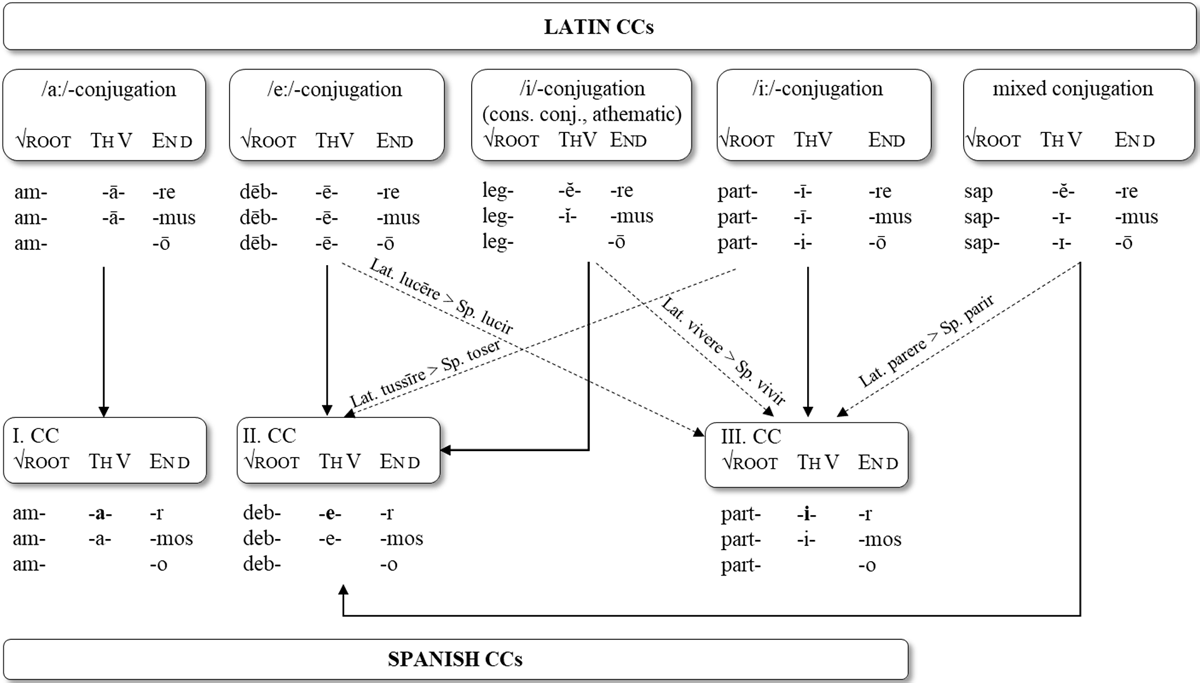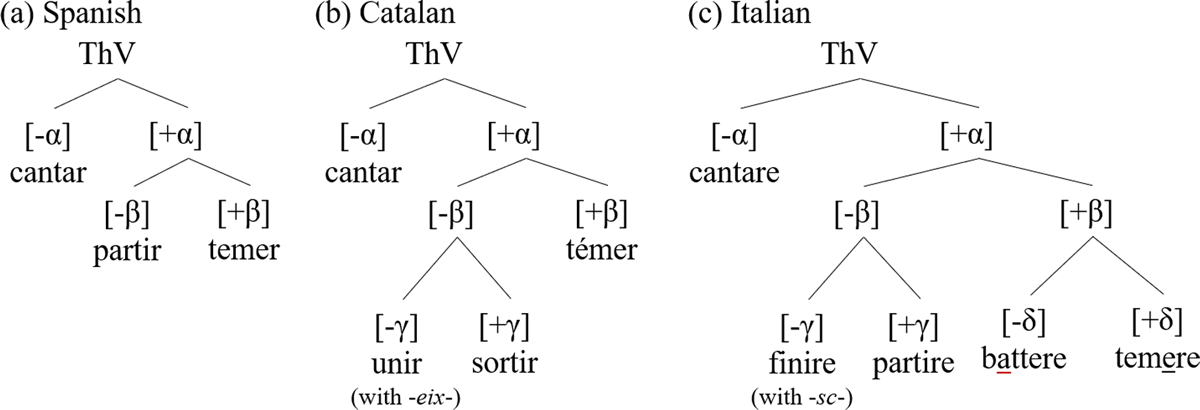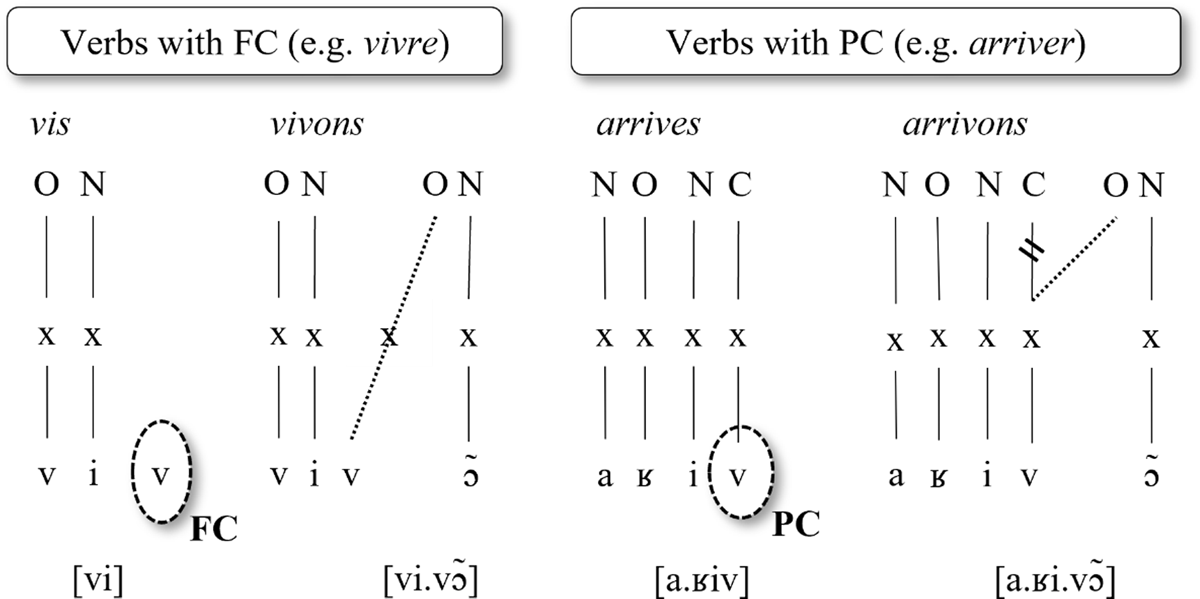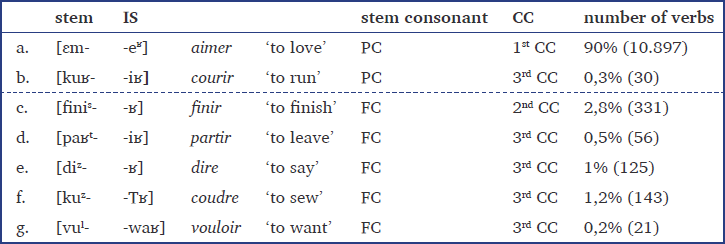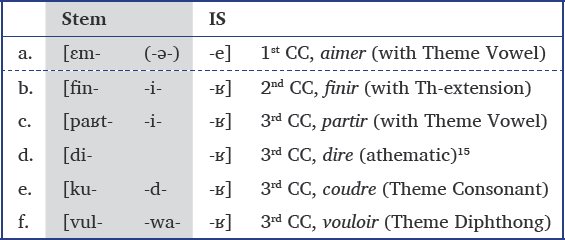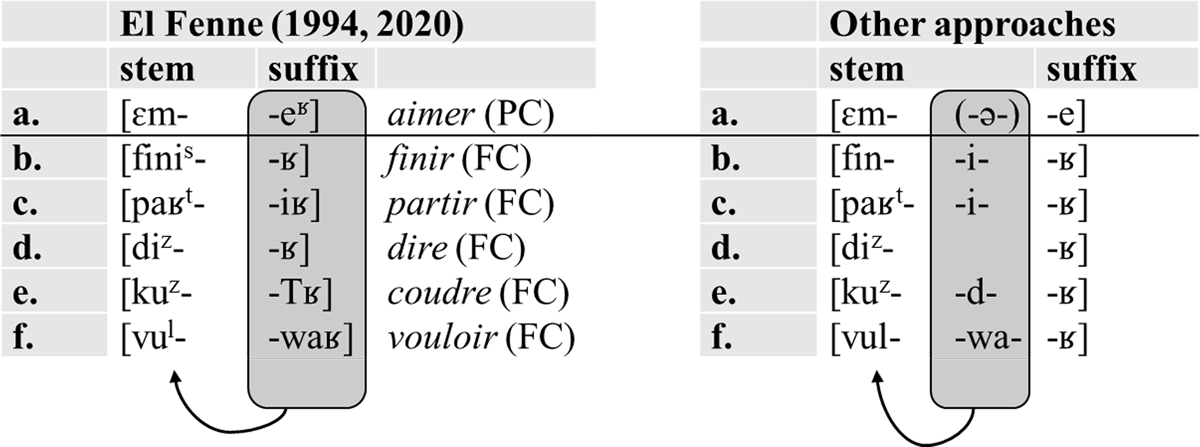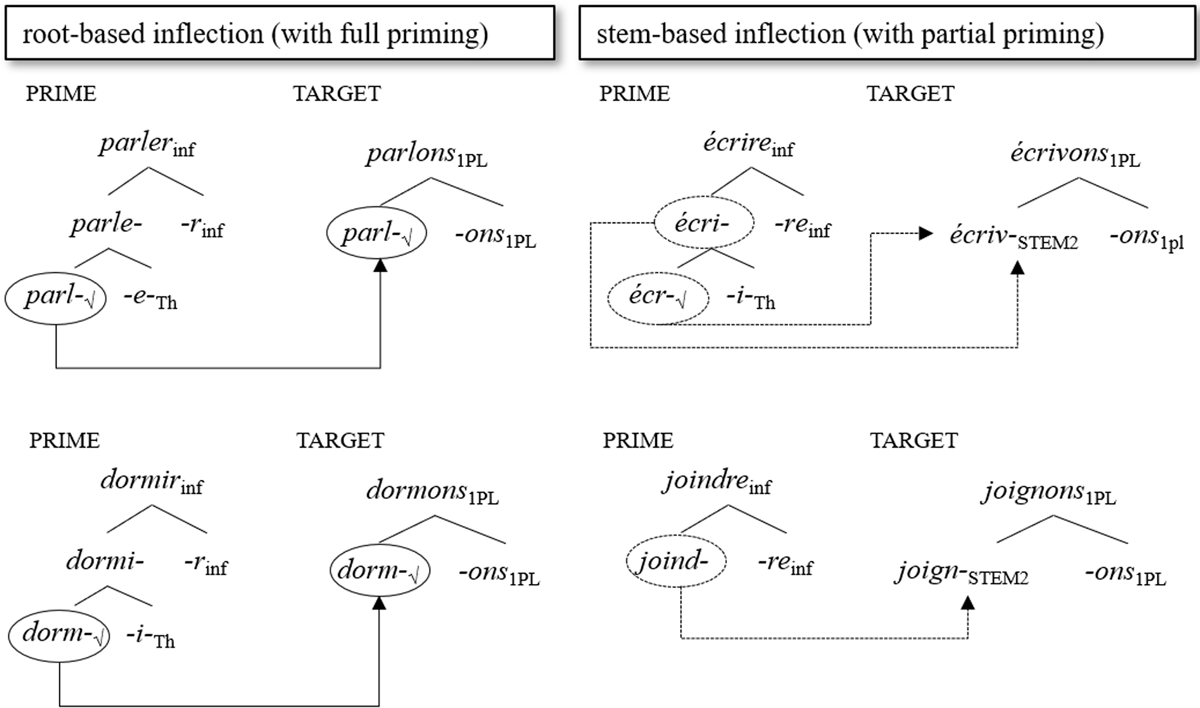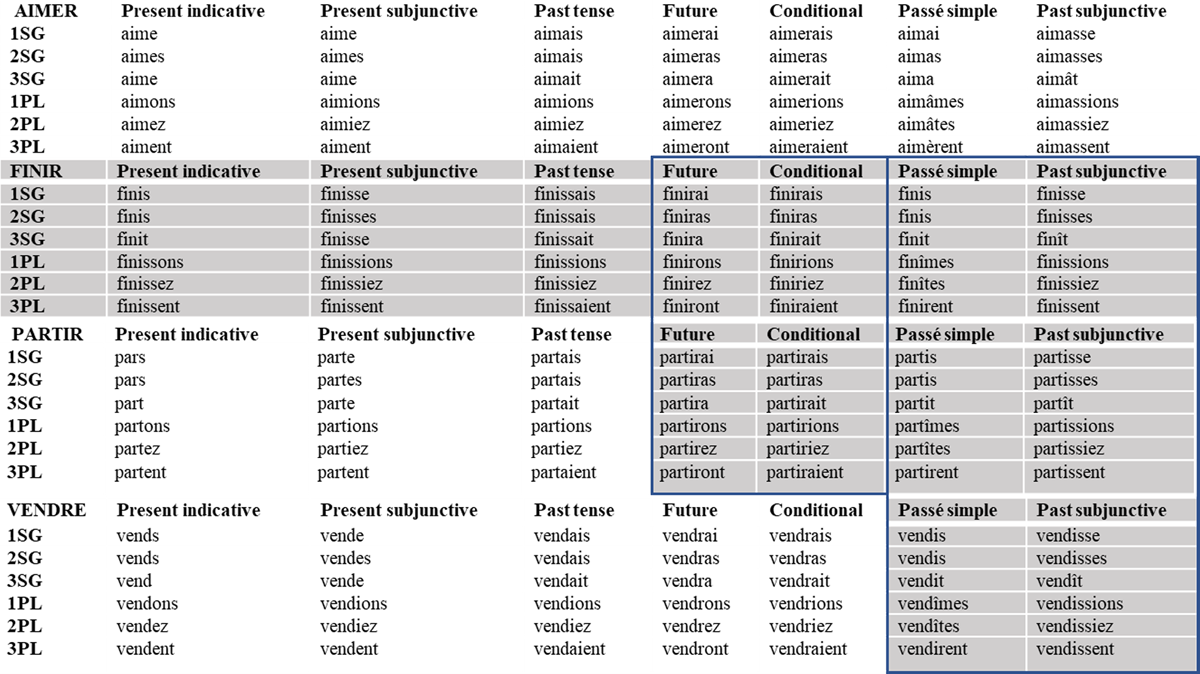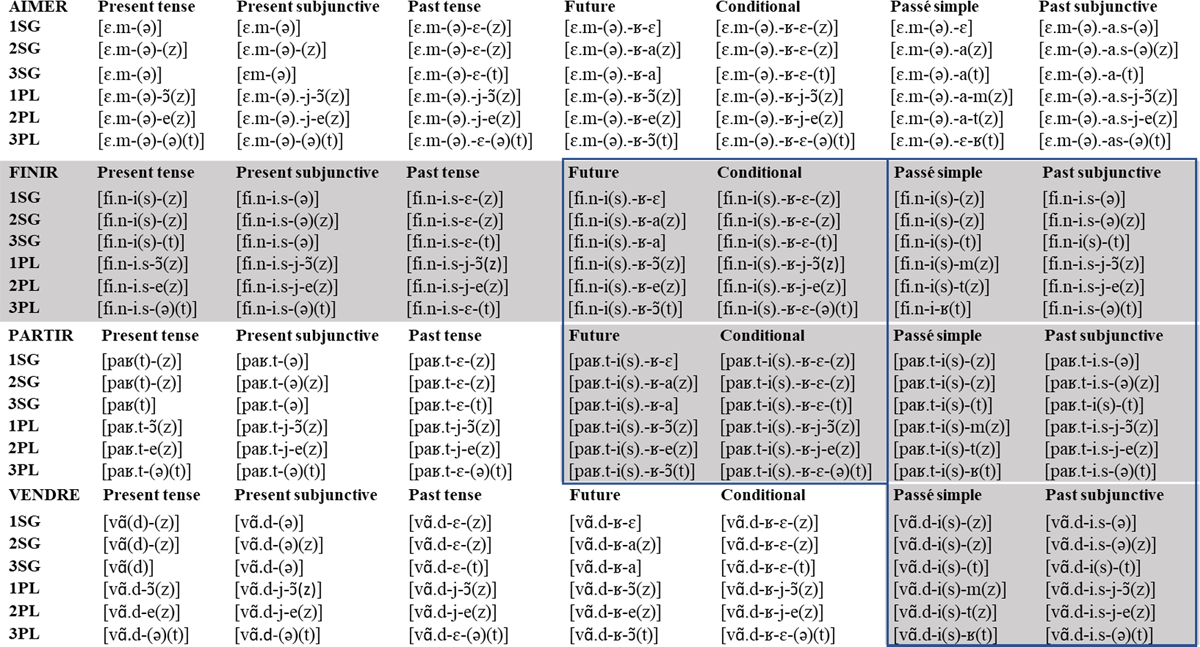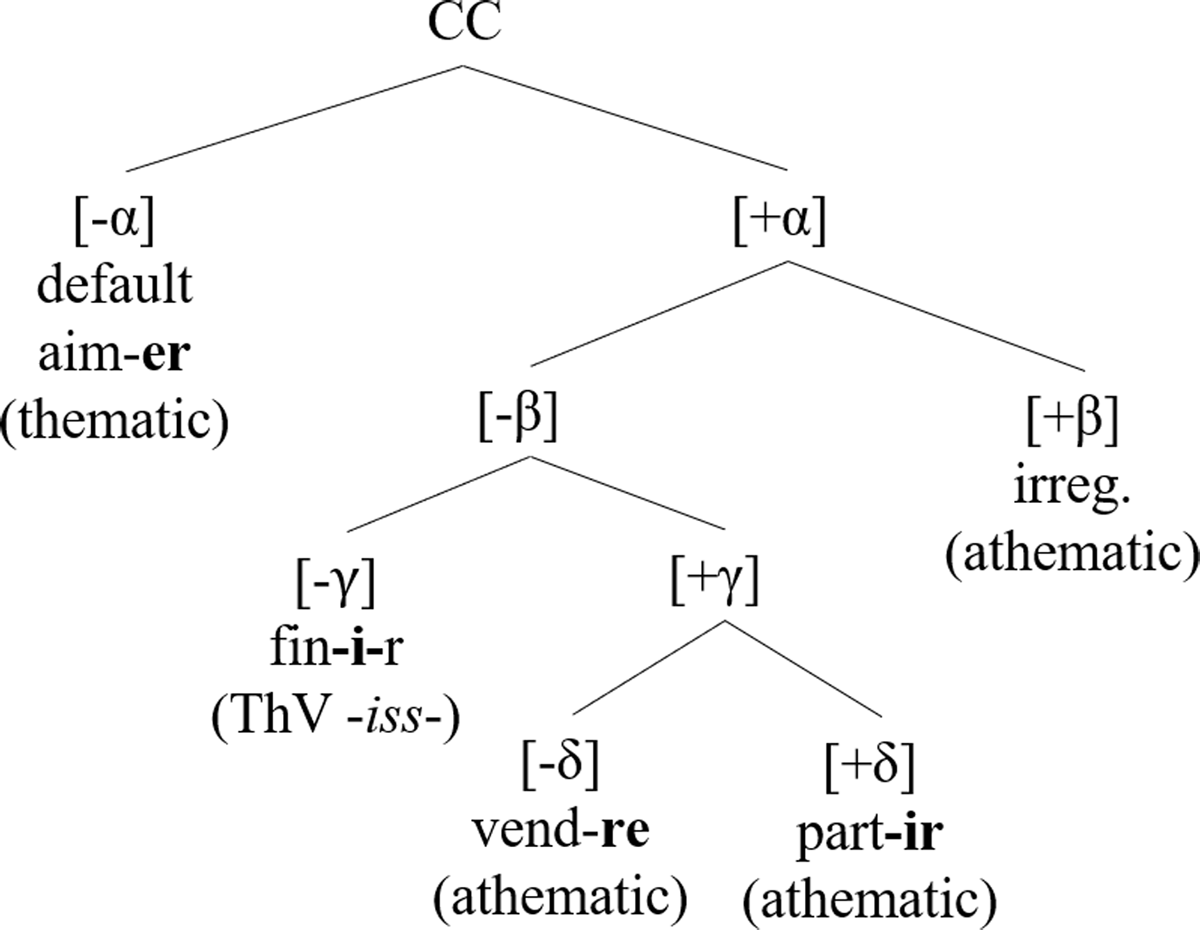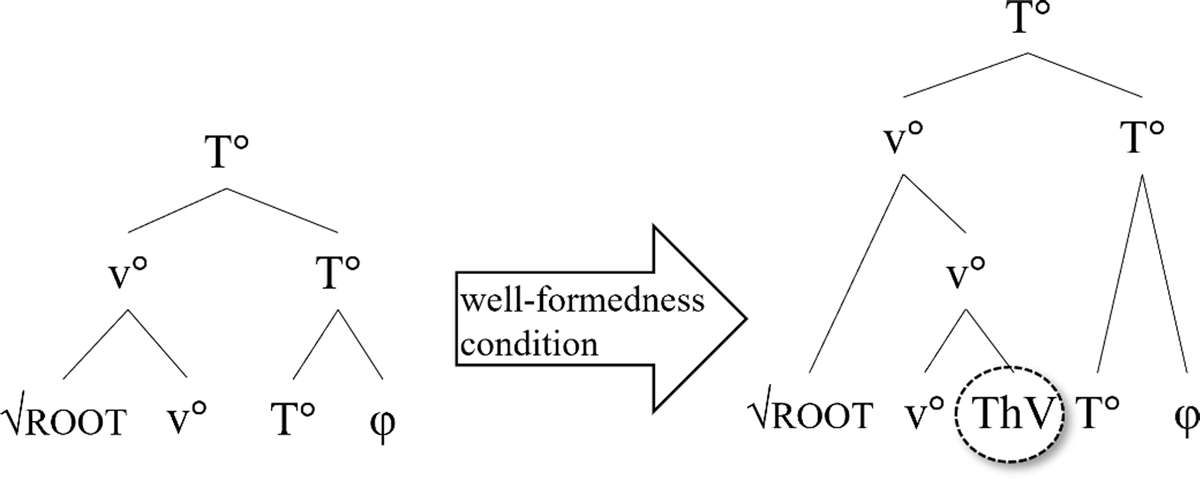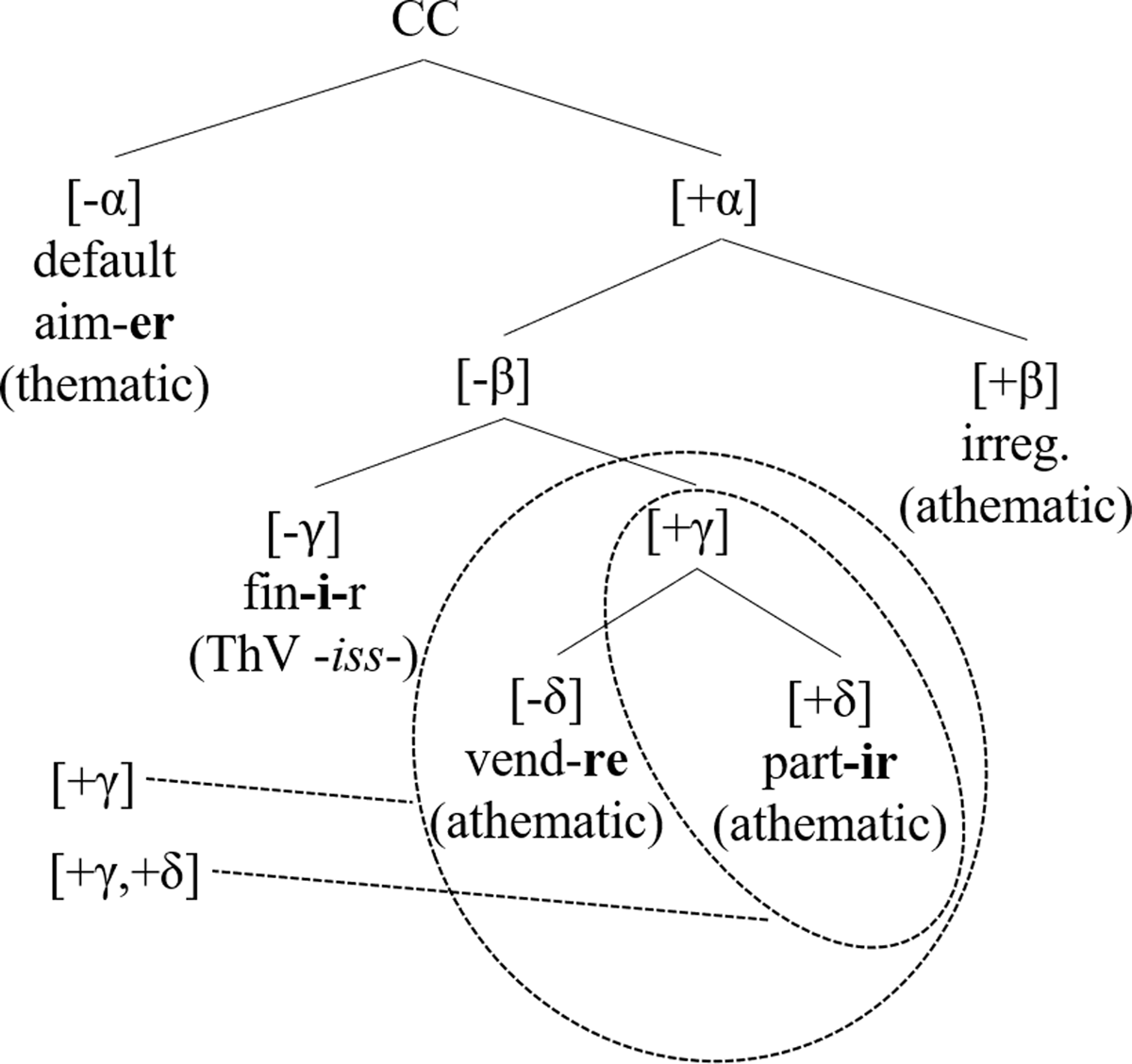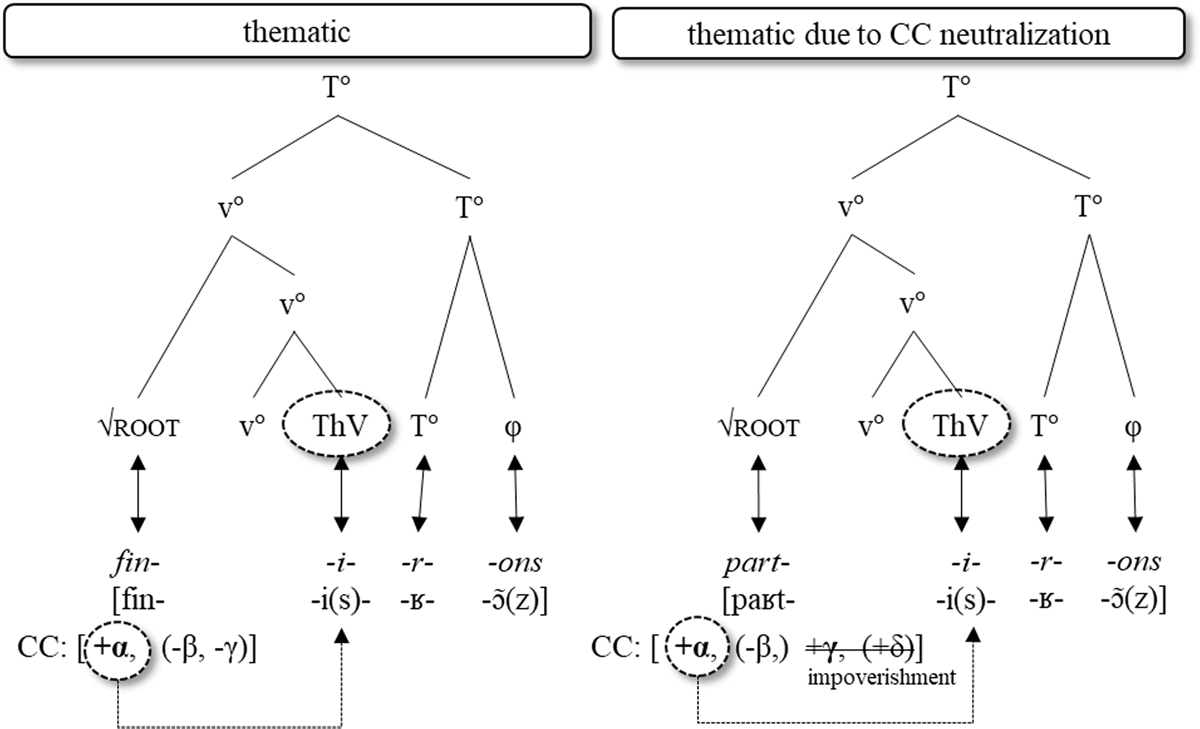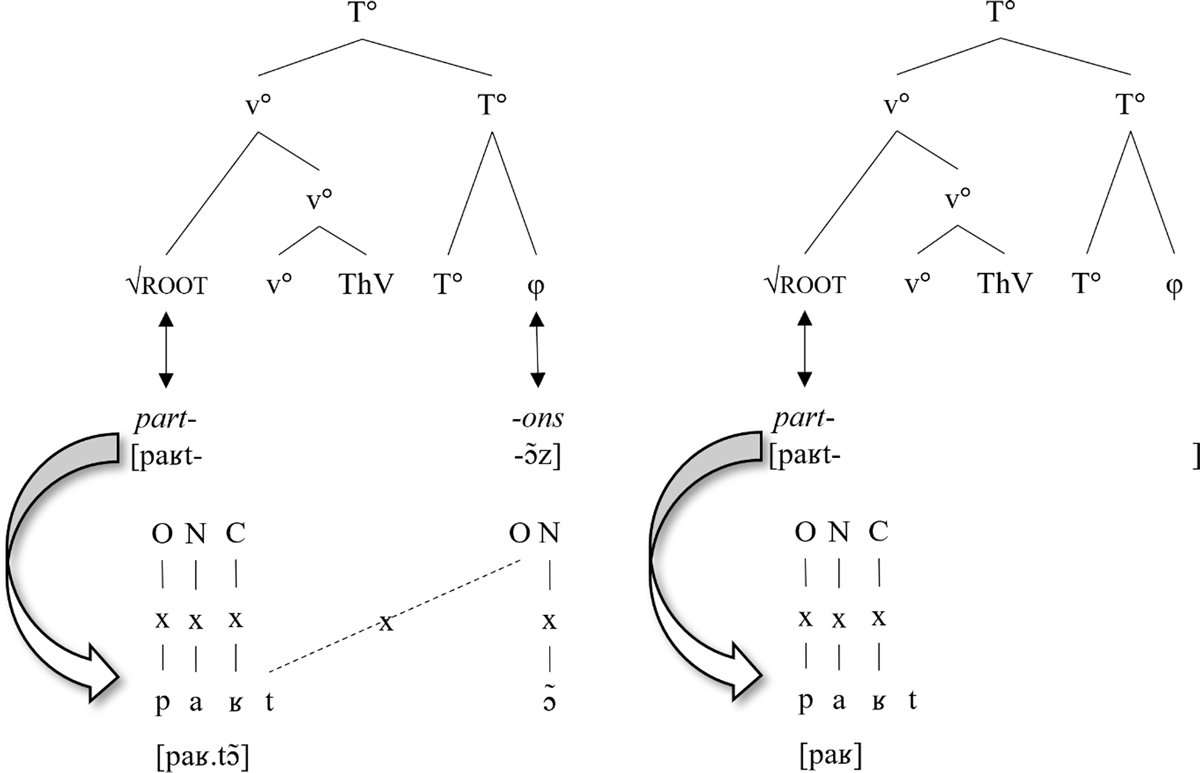1 Introduction
French has many characteristics that set it clearly apart from other Romance languages. One of these is the fact that, in French, the morphological structure of inflected forms generally is less complex with respect to the number of affixes, or at least less transparent. Within the nominal inflection (cf. (1a)), it can easily be shown that French has no nominal class markers in the classical Romance sense and nominal plural has no exponent, at least not in isolation (cf. e.g. Pomino & Stark 2016). While the Spanish noun can be morphologically decomposed into root, word marker (WM) and plural suffix, the same segmentation is impossible for the corresponding French word. Something similar can be observed in the verbal domain: the Spanish verbal form in (1b) can be decomposed in root, theme vowel (ThV) and person-number-suffix, whereas a parallel segmentation for French is again impossible:
- (1)
- a.
- Sp. chic-a-s
- [tʃik-a-s]
- girl.fem-wm-pl
- ‘girls’
- vs. Fr. filles
- [fij]1
- girl[fem.pl]
- ‘girls’
- b.
- Sp. cant-a-s
- [kant-a-s]
- sing-thv-2.sg
- ‘you sing’
- vs. Fr. chantes
- [ʃɑ̃t] (or [ʃɑ̃tz])2
- sing[2.sg]
- ‘you sing’
This article is dedicated to the French verbal inflection. The central question we want to pursue is whether French verbal inflection still has ThVs. We will discuss two possible answers to this question and evaluate several diverging arguments put forward in the literature: (a) Yes, French has ThVs, albeit not in the same extent in which Spanish, Italian or Catalan have them. (b) No, French has no ThV; what seems to be a ThV is either part of the root/stem or the inflectional ending. We will further compare different proposals for the classification of French conjugation classes (CCs) as these are directly related to other assumptions concerning the segmentation of French verbal forms and the acceptance or rejection of ThVs. The research questions we will pursue in this paper are given in (2):
- (2)
- Research questions concerning the French conjugation
- ◦ Is there a verbal form (as the infinitive or other forms of the paradigm) that can be taken as a base of reference in order to define CCs?
- ◦ How does the hierarchical organization of the CC system look like in French?
- ◦ Does French have thematic and athematic CCs, only athematic CCs or are all CCs thematic allowing athematic forms?
- ◦ Into how many constituents can French verbal forms be segmented?
- ◦ Does French have ThVs?
Our analysis unifies assumptions of the more traditional analyses with some aspects put forward by El Fenne (1994; 2020) and Paradis & El Fenne (1995). Our main aim is to show that French has both, thematic and athematic CCs: class I (as it is traditionally called), aimer ‘to love’, and the class of the type finir ‘to finish’ are thematic, whereas the type partir ‘to leave’, the type vendre ‘to sell’, and most other, highly irregular verbs are athematic. In this sense, the hierarchical organization of the CC system in French is different from the other Romance languages. In any case, we are convinced that ThVs, in French as in all other Romance languages, are not verbalizers (cf. Kayne 2016; Fábregas 20173; see also fn. 25), but ornamental morphemes (cf. Oltra-Massuet 1999).
The article is structured as follows: In Section 2 we discuss the Romance CCs as derived from Latin, including the proposals given in the research literature for the classification of French CCs (§2.1) and then concentrate on various possibilities brought forward for the segmentation of French verbal forms (§2.2). In Section 3, we first present some psycholinguistic data that seem to show that French verbs are somehow segmented in a more fine-grained way and especially that (theme) vowels are not part of a non-segmented stem (§3.1). Then we present our own analysis for French verbal forms in Section 3.2, where we propose a feature geometry for French CCs and, based on this, then develop an analysis of the French data in the framework of Distributed Morphology (Halle & Marantz 1993) in 3.3. A short conclusion completes the paper (§4).
2 Romance conjugation classes and the notion of theme vowels
Theme vowels (also linking or connecting vowels), as conceived in this paper, are stem-building vowels which appear between the root and the inflectional ending. In verbal inflection, they build together with the verbal root a stem (or a verbal theme), i.e. they are standardly not attributed to the verbal ending (e.g. Lat. [[am-]root [-ā-]ThV]stem [[-bā-] [-mus]]ending ‘we loved’). As pointed out for instance by Van der Spuy (2020: 1), a ThV “has no easily identifiable morphosyntactic function, though its presence or absence is a partial indicator of different tenses or moods”. Undisputed seems however the fact that in Latin and many other languages CCs are determined (at least partially) based on different ThVs (cf. Leumann, Hoffmann & Szantyr 1963: §398). As illustrated in Table 1, Latin verbs are classed into five conjugations:4 three CCs (I, II, IV) have a long ThV, whereas the remaining two CCs have either a short or, in some forms, an epenthetic vowel (cf. Halle 2018, Van der Spuy 2020 for more details). The 3rd CC with /i/ is also called “consonantal” or athematic,5 i.e. in some Latin grammars the vowel is not considered to be part of the stem, but epenthetic (amā-re ‘to love’, but leg-e-re ‘to read’, cf. Kühner & Holzweissig 1912: 659). What is more, also CCs with long thematic vowels have athematic forms due to different contextual conditions, e.g. phonological preferences as the avoidance of a hiatus: In the 1st person singular in the present tense, e.g., there is no ThV between the root and the inflectional ending: am-ō ‘I love’ < *am-ā-o6. With respect to athematicity (for languages where thematic elements play a role for the definition of different CCs), we have to distinguish thus at least three different cases: (i) athematic CCs (e.g. the consonantal conjugation legere ‘to read’, cf. above), (ii) grammatically conditioned athematic verbal forms of thematic CCs (e.g. thematic imperfect form man-ē-bā-mus vs. athematic perfect form mān-si-mus ‘we remained’; cf. e.g. Halle 2018: 5) and (iii) athematic forms due to phonological reasons (e.g. am-ō ‘I love’; cf. e.g. Van der Spuy 2020: 5). The latter are the result of (formerly or still) active phonological rules and will not be an issue in what follows. We will rather focus on whether or not French CCs are thematic or athematic and how (a)thematicity can be implemented within the framework of DM (cf. §3.2 and §3.3).
Latin CCs (cf. a.o. Halle 2018).
| /a:/-conjugation | /e:/-conjugation | /i/-conjugation (cons. conj., athematic) | /i:/-conjugation | mixed conjugation | ||||||||||
| ‘to love’ | ‘must’ | ‘to read’ | ‘to divide’ | ‘to know’ | ||||||||||
| am- | -ā- | -re | dēb- | -ē- | -re | leg- | -e- | -re | part- | -ī- | -re | sap- | -e- | -re |
| am- | -ā- | -mus | dēb- | -ē- | -mus | leg- | -i- | -mus | part- | -ī- | -mus | sap- | -i- | -mus |
| am- | -ō | dēb- | -e- | -ō | leg- | -ō | part- | -i- | -ō | sap- | -i- | -ō | ||
Modern Romance does not preserve the historical vowel length distinction and, obviously, the loss of phonemic vowel length directly impinged on the evolution of the CCs of the Romance languages. All Romance languages have reduced the Latin CC system, usually to three main classes (with subclasses)7, albeit with different results. The notion ThV applied to Romance is usually understood as a vowel that can be derived from the verbal form of the infinitive. As will be seen in the next chapter, the notion of ThV can also be extended in the sense that it comprises more complex elements, like theme diphthongs, theme consonants or augmented forms of ThVs, depending on the segmentation proposed for the verbal forms (cf. e.g. Table 6). In section 2.1, we will first discuss the results of this reduction and turn afterwards (§2.2) to the challenges of the French CCs.
2.1 From Latin to Romance
For reasons of space, we cannot discuss all aspects of the evolution of the Romance CC systems. What should become clear is the fact that Spanish, Catalan and Italian (and other Romance languages) have reduced the number of Latin CCs, maintaining at the same time without any doubt ThVs in their verbal inflection. In Spanish, for instance, Latin ThVs -ā- / -ē- / -ī- developed, as a rule, to Spanish -a- / -e- / -i- respectively, with some exceptions for -ē- and -ī- (cf. Figure 1 where the dotted lines illustrate the exceptions and the solid lines the rule). In contrast, the Latin consonantal conjugation, i.e. the one we call athematic, as well as the mixed conjugation, got lost and the corresponding verbs (if they survived at all) were integrated – again with minor exceptions – into the 2nd CC of Spanish. This means that, in Spanish, all CCs are thematic CCs, even though we find athematic forms due to phonological reasons (e.g. canto ‘I sing’ vs. *cantao). Suppletive verbs like e.g. ir ‘to go’ may be an exception to this generalization (cf. Pomino & Remberger 2022a/b).
More precisely, the Spanish CCs can be identified by the infinitival form, which has either of the ThVs -a-, -e- and -i-. There is, however, also a number of inflected forms which surface without a ThV: the 1st person singular present indicative (e.g. cant-o ‘I sing’, beb-o ‘I drink’ and part-o ‘I leave’), all persons of the present subjunctive (e.g. cant-e, beb-a and part-a)8, the 1st person singular indefinido (i.e. the simple past as derived from the old Latin perfect, e.g. cant-é ‘I sang’, beb-í ‘I drank’ and part-í ‘I left’) and the 3rd person singular indefinido of the first CC (e.g. cant-ó ‘she sang’). Even though Spanish has athematic forms, the CC system is nevertheless clearly defined by ThVs.
Another interesting aspect of the Spanish CC system (valid in similar vein for Catalan and other Romance languages) is the fact that in many tenses the 2nd and 3rd CC are neutralized, that is they both either show -e- (or rather -ie-) or -i-, e.g. beb-e-n ‘they drink’ / part-e-n ‘they leave’, beb-ie-ron ‘they drankindefinido’/ part-ie-ron ‘they leftindefinido’, beb-í-a-n ‘they drankimperfect’/ part-í-a-n ‘they leftimperfect’. In other words, only in 16 out of 59 synthetic forms that a Spanish (non-defective) verb has the two CCs show different ThVs. In all other cases, they are not distinguishable by the ThVs. This is completely opposed to the 1st CC, in which all thematic forms have the ThV a or, put differently, which is never neutralized with respect to another CC. What is more, the 1st CC stands out also due to its productivity, the very small number of irregular verbs (out of 9986 verbs only 333 are considered to be irregular, cf. Alcoba 1999: 4936)9 and the number of verbs it contains – according to Alcoba (1999: 4936), 90.75% (i.e. 9986 verbs) belong to the 1st CC, 4.75% to the 2nd and 4.6% to the 3rd CC.
These observations lead us to the assumption that even though all CCs are thematic in Spanish and other Romance languages, the CCs differ with respect to their markedness. In all these languages the respective CCs are not equally productive, not equally regular and they also have different dimensions as far as the number of members is concerned. What is more, CC oppositions may be neutralized. Oltra-Massuet (1999; 2020) argues based on this line of reasoning that ThVs are bundles of subatomic abstract features organized in a markedness hierarchy or feature geometry, cf. Figure 2:
Conjugation Classes (regular verbs): Spanish (a), Catalan (b) (Oltra Massuet 1999; 2020: 287) and Italian (c) (based on Napoli & Vogel 1990).
In French, ThVs, in contrast, have developed in a different way (cf. Table 2) and, up to now, there is no consensus in the literature with respect to whether Modern French has ThVs and how the CCs are to be described.
From Latin to French (cf. a. o. Foley 1979: 135).
| Latin | French | general rule (not exceptionless) | |
| am-ā-re > | aimer | ‘to love’ | Latin -ā- developed to -e- |
| sent-ī-re > | sentir | ‘to feel’ | Latin -ī- “remained” -i- |
| val-ē-re > | valoir | ‘to be worth’ | -ē- diphthongizes to [wa] (“thematic diphthong”) |
| scrib-e-re > | écrire | ‘to write’ | -e- (or rather /i/) is “lost” (= athematic) |
Modern French verbs are traditionally divided into three CCs (or four, if verbs ending in -oir are not included in the 3rd CC on -re) based on the form of the infinitive (cf. e.g. Meyer-Lübke 1908: 202): Verbs of the 1st CC have an infinitival form ending in -er [-eʁ], e.g. aimer [ɛme] ‘(to) love’. This CC does not only include 90% of all French verbs, but it is also highly productive. Apart from aller ‘to go’, which shows suppletion and therefore doesn’t belong to the 1st CC since it unites forms going back to verbs of different CCs, most verbs ending in -er are classified as being regular, in the sense that they have only one single stem for all tense forms. Only a few verbs have stem allomorphy, but – as shown e.g. by Meunier & Marslen-Wilson (2004) – these all count as phonologically predictable changes. The stem allomorphy found in lever [lǝ.veʁ] ‘to lift’ vs. lève [lɛv] ‘(I) lift’, for instance, is explainable based on the distinction between open and closed syllables. In sum, due to the mentioned characteristics, the 1st CC is the unmarked CC. The 2nd CC is characterized by infinitives ending in -ir [-iʁ] and the verbs of this class have a short and a long or extended stem, e.g. finis [fini] ‘(I) finish’ vs. finissons [finisɔ̃n] ‘(we) finish’. This CC is also considered to be fully regular; according to Gertner (1973: 19) the number of regular verbs within this CC is even higher than the one of the 1st CC. However, the 2nd CC entails only 2,8% of all French verbs and it is generally – with a few exceptions, including some recent newcomers (cf. §3.2) – considered to be no longer productive, a fact that makes it more marked than the 1st CC. The 3rd CC is in essence a smorgasbord of all other verbs that do not belong to the 1st or the 2nd CC. Verbs belonging to this class are, for instance, romp-re ‘to break’, pein-dre ‘to paint’, voul-oir ‘to want’, dorm-ir ‘to sleep’ (without -ss-extension) and also all-er ‘to go’. This CC contains many irregular verbs with stem allomorphy and also several suppletive verbs (where the whole inflected form is affected by irregularity, not only the root/stem). It goes without saying that this CC is unproductive and counts as the most marked class.10
However, especially for French there are many other proposals for the morphological classification into different verb classes. For instance, Dubois (1967) turns away from the diachronically motivated classification along the form of the infinitive and proposes instead a classification based on the number of stems a verb allows: one stem (e.g. chanter ‘to sing’: chant-), two stems (e.g. écrire ‘to write’: écri-, écriv-), three stems (e.g. plaindre ‘to complain’: plain-, plaign-, plaind-), four stems (e.g. connaître ‘to know’: connai-, connaiss-, connaît-, conn(u)-), five stems (e.g. vouloir ‘to want’: veu-, voul-, veul-, voud-, veuill-) and six stems (e.g. pouvoir ‘can’: peu-, pouv-, peuv-, puiss-, pour-, p(u)-). Other researchers try to reduce the number of different stems to an absolute minimum and to give a rather rule-based explanation. El Fenne (2020), for instance, does not assume two stems for écrire (écri- and écriv-) as Dubois (1967) does, but rather one single stem that has a floating consonant (i.e. écriv-). Floating consonants are overtly realized only if they can occupy the onset position of a following syllable (cf. é.cri.vons vs. é.crit) (cf. §2.2 for more details).
Now, when looking at the infinitival forms of French verbs, there are different proposals in the literature for possible segmentations: The “outcome” of the former Latin ThVs is either segmented as belonging to the verb ending (cf. (3a)), or it is added to the root to form a thematic stem (i.e. root + ThV; cf. (3b)), or it is seen as part of a non-segmented stem (cf. (3c)). In two of these three possibilities the vowel is no longer conceived as ThV (cf. (3a,c)), whereas in the remaining third case (3b) the notion of ThV is even expanded by including also theme consonants and/or theme diphthongs (cf. Table 6 further below).
- (3)
- a.
- b.
- c.
- aimer
- aimer
- aimer
- [ɛm-eʁ]
- [ɛm-e-ʁ]
- [ɛme-ʁ]
- the vowel is no longer conceived as ThV
- with a ThV between the root and the verbal ending
- the vowel is no longer conceived as ThV
In sum, some linguists follow the rather traditional classification and consider -r to be the infinitival ending (cf. (3b,c)), whereas the preceding vowel is classified as theme vowel/theme diphthong or seen as part of a non-segmented stem. Others propose instead to analyse -er, -ir, -oir and other endings as purely infinitival, i. e. inflectional. Note, however, that in some proposals the segmentation chosen is not the same for all verb types, but may differ from verb type to verb type (cf. Table 3).11
Proposed endings for French infinitival forms (modified from El Fenne 1994: 109 and Paradis & El Fenne 1992).
| Authors | proposed suffixes for the infinitives of ‘to love/to finish/to leave/to be worth/to sell/to say’ | |||||
| aimer | finir | partir | valoir | vendre | dire | |
| Michaut (1934), Dupuis (1935), Larousse (1936), Grevisse (1969) | -er | -ir | -ir | -oir | -re | -re |
| Schane (1968) | -e | -ir | -ir | -r | -r | -r |
| Paradis & El Fenne (1992) | -er | -r | -ir | -oir | -tr/dr ([Tʁ]) | -r |
| Csécsy (1968), Martinet (1969) | -e | -r | -r | -r | -r | -r |
| Van den Eynde & Blanche-Benveniste (1970) | -er | -r | -r | -r | -r | -r |
| Pinchon & Coute (1981), Plénat (1981) | -e | -r | -r | -r | -r | -r |
As (3) and Table 3 show, the assumption of ThVs for French and thereby the classification of the CC system along ThVs has been put into question, not only for the infinitival forms, but also for many finite forms since they are, at least superficially, athematic (cf. Table 4). One question to be answered, however, is whether in the case of French we are dealing with athematic forms or completely athematic conjugations. As illustrated above, also in Latin and Spanish thematic CCs have athematic forms.
Selected finite verbal forms.
| aimer | sentir | valoir | écrire | |||||
| 1sg | aime | [ɛm] | sens | [sɑ̃n-z] | vaux | [vo-z] | écris | [ekʁi-z] |
| 1pl | aimons | [ɛm-ɔ̃z] | sentons | [sɑ̃nt-ɔ̃z] | valons | [val-ɔ̃z] | écrivons | [ekʁiv-ɔ̃z] |
In the following section we will discuss one proposal with and another one without the consideration of ThVs in order to find out which challenges each approach is confronted with.
2.2 Approaches with and without theme vowels for French verbal inflection
Let us start with approaches where the existence of ThVs is denied and the vowel present in the infinitival form is instead assigned to a non-segmentable stem and/or to the ending (cf. possibilities (3a,c) above). Among the various proposals based on this idea we will discuss the work of El Fenne (1994, 2020). A basic argument for El Fenne’s classification for French CCs is the contrasting behavior with respect to the consonant-zero-alternation found in different roots with apparently identical phonological environments. The root final consonant of viv(re) ‘to live’, e.g., is maintained if there is a possibility for it to appear in a syllable onset, e.g. before a vowel (e.g. nous vivons [vi.vɔ̃(z)] ‘we live’) or a consonant with which it can build a complex onset (e.g. nous vivrons [vi.vʁɔ̃(z)] ‘we will live’), but it is deleted before a following consonant with which it cannot form an onset (tu vis [vi-(z)] ‘yousg live’). However, the same final consonant of the verb arriv(er) ‘to arrive’, in contrast, is never deleted: tu arrives [aʁiv-(z)] ‘yousg arrive’, and not *tu arris [aʁi-(z)]. Instead of assuming two different stems for vivre (i.e. viv- and vi-) and one for arriver (i.e. arriv-), El Fenne (2020) proposes that French verbs must be classified based on whether the verb stem ends in a permanent consonant (PC) or in a floating consonant (FC). Stem final PCs are never affected by consonant deletion, i.e. irrespective of the following element, they are phonetically realized, while stem final FCs (annotated as superscript consonants) are realized only if they can be linked with the onset position of a following element: Thus, the stem viv- is represented in the lexicon as having a FC. In case of nous vivons, the FC is linked on the skeletal tier to the open x-slot of the affix -ons, while it will not surface in case of tu vis, since there is no following x-slot available. In contrast, the final consonant of the stem arriv- will always be realized since it has a PC, i.e. it is already associated with its own x-slot in its lexical entry. In case of the verbal form nous arrivons, there will be only “relinking” from the coda position into the onset position. In this analysis, both verbs have only one stem. The realization of the final consonant depends on whether it has a FC or a PC, i.e. the phonological process is triggered by this information alone and does not affect all final consonants, cf. Figure 3. We would like to refer the reader to El Fenne (2020: 35) for a table which contains an inventory of floating consonants of French verbal stems. El Fenne’s inventory of the floating consonants does not exactly correspond to the latent consonants involved in the (word-external) sandhi phenomenon of liason.
Now how does the distinction between FC and PC correlate to the CCs? There is no one-to-one correlation between CCs and PC or FC, but a clear tendency can be observed. According to Paradis & El Fenne (1995: 198–199), 94% of the French verbs (11.294 verbs; cf. Bescherelle 1985; 2019 for concrete numbers) belong to the 1st CC. Out of these, 4% have a stem ending with a vowel and in the remaining 90% the stems end in a consonant that is a PC. There is, however, a small number of verbs (0,3%, i.e. 30 verbs) belonging traditionally to the 3rd CC that also have a PC ([ʁ] or [j], e.g. courir ‘run’). All other verbs, whether they belong to the 2nd or 3rd CC, have FCs. Leaving minor exceptions aside, we can summarize this correlation as given in Table 5.
Twofold classification based on the verb stem (El Fenne 1994, 2020).
However, El Fenne’s classification with respect to the verb stems is problematic with respect to the number of the infinitival endings: Although she assumes only two types of stem, she has to posit six different endings for the infinitive (as Table 5 shows). Yet, from her analysis, it is not clear how the stems select their corresponding endings. Probably she has to assume special (readjustment) rules that would be extremely complex and unmotivated. What is more, also for finite forms, El Fenne (2020) proposes a segmentation into only two constituents. For this, she posits further verbal stems for the future tense and the conditional and cumulative inflectional endings for tense and agreement (e.g. -ions [jɔ̃] for the 1st person plural imperfect indicative), which she terms a general affix (GA). Figure 4 contrasts the present tense form for the 1st person plural with the corresponding future form, the conditional, and the imperfect form as they are analysed by El Fenne. Due to the rather poor segmentation of French verbal forms into only two parts, El Fenne (2020) has to posit specific stems for the future (and conditional) and a specific GA for the imperfect (and conditional), even for the completely regular 1st CC which is characterized by having no stem (or root) allomorphy (apart from regular phonological changes). Both her assumptions are highly disputable: El Fenne (2020) argues that the future and the conditional are built on the basis of the infinitive form. Yet, the infinitive aimer is [ɛmeʁ], not [ɛməʁ].12 That is, she must either explain the vowel reduction or assume a specific stem for the future (and conditional). A more serious problem is, in our opinion, the GA [jɔ̃] for the imperfect (and conditional) form. Except for the passé simple – a tense which has many idiosyncrasies in all Romance languages – the 1st person plural is always realized as [ɔ̃] in French – so why should we assume such a GA and dispense with an obvious regularity. One could also associate [j] with the stem, but even this would again lead to a higher number of stems and an unnecessary complication of the inflectional system.
Comparison of different tense forms based on El Fenne (2020).
In sum, in El Fenne’s approach, the reduction of the structural complexity to only two constituents goes hand in hand with an increase of allomorphy. We also think that, if there is something really regular within French inflection, it is the person-number suffix [ɔ̃] for the 1st person plural (and [e(z)] for the 2nd person plural). The segmentation proposed by El Fenne would interpret this regular element as an irregular element.
Let us now turn to an analysis that posit ThVs also for French. As we have already seen, there is no consensus at all in the literature with respect to the shape of French infinitival suffixes. There are several proposals and researchers count with up to six different infinitival endings. It goes without saying that, depending on which segmentation one is willing to accept, we are faced with different problems to be solved. Those approaches who assume that the ThV is part of the stem have proposed a binary opposition for the infinitive ending (e.g. Martinet 1969; Van den Eynde & Blanche-Benveniste 1970; Pinchon & Coute 1981; Plénat 1981). For them, the infinitive of the 1st CC ends in [-e] (or rather [-eʁ])13, whereas in all other cases it is marked by [-ʁ]. In these approaches, the verb stem (highlighted in grey in Table 6) is generally further segmented into √root and ThV. Standardly, verbs of the 1st, the 2nd and some of the 3rd CC count as being thematic in many traditional works. Other 3rd CC verbs (e.g. dire, vivre) are analyzed as athematic. Finally, some researchers also argue for the presence of theme consonants and theme diphthongs, as given in Table 6. The challenge for those who maintain this segmentation lies in explaining, among other things, how which theme element is combined with which √root.14
Classification based on the infinitive ending (IS = inflectional suffix).15
Evidence for assuming ThVs in French for the 1st CC comes from the consonant-zero-alternation mentioned before and again illustrated in Figure 5: As said before, the root final consonant of viv(re) ‘to live’, which in these approaches belongs to an athematic CC, is maintained, if there is a possibility for it to appear in a syllable onset, otherwise it is deleted. The same final consonant of arriv(er) ‘to arrive’, which is thematic, is never deleted. Schane (1966; 1968) and others assumes that in this case the ThV /ǝ/, which does not surface, blocks consonant deletion (cf. /aʁiv- (ǝ)+(z)/).16 In this case, both verbs have just one root/stem (/viv-/ and /aʁiv-/) and the realization of the final consonant depends on the following element.17
The assumption of the presence of a ThV for the CC of finir ‘to finish’ is straightforward for many linguists, since here the ThV surfaces as either [i] or [is].18 With respect to the [i]-[is]-alternation, Schwarze (2009) assumes that the underlying form of the ThV is, in all cases, /is/. The /s/ of this theme element surfaces only when it can occupy an onset position in the syllable structure (cf. the plural forms of finir in Table 7), otherwise it is deleted. As can be seen from this example, it is sufficient to assume only one root/stem and one ThV; the corresponding surface forms result from regular phonological processes.
Forms of finir (adapted from Schwarze 2009).
| morphological structure | syllable structure | surface form19 | |||||
| root | ThV | φ | -liaison | +liaison | spelling | ||
| 1sg | fin | is | z | fi.nisz | [fi.ni] | [fi.ni.zV] | finis |
| 2sg | fin | is | z | fi.nisz | [fi.ni] | [fi.ni.zV] | finis |
| 3sg | fin | is | t | fi.nist | [fi.ni] | [fi.ni.tV] | finit |
| 1pl | fin | is | ɔ̃z | fi.ni.sonz | [fi.ni.sɔ̃] | [fi.ni.sɔ̃.zV] | finissions |
| 2pl | fin | is | ez | fi.ni.sez | [fi.ni.se] | [fi.ni.se.zV] | finissez |
| 3pl | fin | is | ət | fi.ni.sət | [fi.nis] | [fi.nis.tV] | finissent |
There is thus evidence for assuming ThVs for the CC of type aimer and the CC of the type finir. However, things are different for verbs belonging to the remaining verbs since these do not form a class but are completely heterogeneous with respect to potential ThVs, as the examples c.-f. in Table 6 show. If we were to analyse these forms as containing ThVs, we would either be forced to build subclasses and motivate these subclasses, or again to assume special (readjustment) rules and motivate these. In other words, while the combination of the root and the ThV is straightforward for verbs of the type of aimer and finir, it is not clear how this can be done for the remaining verbs unless one is willing to propose unmotivated diacritic features and/or (readjustment) rules.
To sum up, both approaches discussed in this section have, in our opinion, the same basic problem: Approaches like El Fenne (1994; 2020) try to keep the stems as regular as possible, which means that they have to assume various allomorphic suffixes for the same verbal form (e.g. the infinitive). The other approaches strive for the minimal allomorphy of inflectional endings (e.g. only -e and -r for the infinitive), but then have to shift irregularity to the stem (cf. Figure 6).
The framed elements in Figure 6 are the ones that contain the irregularity and in both general approaches it remains unclear how the correct combination of stems and suffixes is achieved: What prevents [vul-] to be combined with [-iʁ], for example? We instead treat ThVs as autonomous elements that are situated between a stem and the inflectional ending. We also believe that the infinitival forms in French are exceptional (since some of them, e.g. partir, are neutralized in some forms of the paradigm, cf. §3.2 below) and do not give us a clear picture of ThVs. In our analysis, we will follow a mixed approach, considering ThVs relevant, but only for some CCs. Some of the arguments given in the literature will be used in our analysis, which is mainly based on the assumption that also in French verbs can be segmented into root, ThV, and ending.
In the approaches presented above, there are, however, important differences with respect to the segmentation of the verbal forms. In more traditional approaches, the stem is further segmented into root and ThV (or Th-diphthong or ThC), whereas it is one single unit in the proposal by El Fenne (2020). In her proposal, what we might analyze as ThV, is either part of the stem (cf. fini-r) or part of the ending (cf. dorm-ir). The question is whether there is any theory-external evidence for a fine-grained segmentation for French verbal forms or whether they are only segmentable in a stem and an ending. To pursue this question, we will make a small digression into psycholinguistic studies at the beginning of the next section.
3 A mixed CC system: Thematic and athematic conjugation classes
The aim of this section is twofold: On the one hand, we will argue that French has thematic and athematic CCs, a fact which is directly related to structural complexity; in this context, we will propose a feature geometry for French. On the other hand, we will show that with our proposal we can avoid some problematic aspects of El Fenne’s analysis. In Section 3.1 we start with psycholinguistic evidence for segmentation of the French verb, in Section 3.2 we propose a feature geometry for French CCs and in Section 3.3. we present an analysis for mixed patterns in the French CCs.
3.1 Psycholinguistics evidence for the segmentation of French verbs
As shown in Section 2, there is no consensus in the literature with respect to the segmentation of French verbs. A verb like partir ‘to leave’ could be segmented e.g. in the following three ways: part-i-r (with autonomous ThV), parti-r (where the vowel is part of a no further segmented stem) or part-ir (where the vowel is part of the verbal ending). In this subsection we briefly discuss psycholinguistic studies concerning the mental representation and processing of verbal stems and conjugation classes in French in order to find out whether these provide evidence for one of the three possibilities or whether we can, at least, exclude one of the possibilities.
Estivalet & Meunier (2015a/b; 2016) conducted two priming experiments – a cross-modal priming experiment (CMPE) and a masked priming experiment (MPE) – to find out how French verbs are processed. The basic assumption behind both experiments is that the response with respect to the target is (positively or negatively) influenced by the prime. The authors considered two conditions with different priming predictions and an additional test condition: (a) In the identity condition, prime and target are identical (e.g. parlons ~ parlons) and full priming is predicted. (b) No priming is predicted in the control condition where the prime is the infinitive form of one verb, while the target is an inflected form of another verb (e.g. aimer ~ parlons). (c) In the test condition, the prime and the target belong to the same verb, but the prime is given in the infinitive and the target is an inflected form (e.g. parler ~ parlons). With respect to this test condition, Estivalet & Meunier (2015a/b; 2016) posited the following three hypotheses (RT = Reaction Time).
- (4)
- a.
- If there is no priming (i.e. same RT for control condition and test condition), the verb is not decomposed (i. e. whole-word recognition).
- b.
- If there is full priming (i.e. same RT for identity and test), the verb is completely decomposed (e.g. into √ + ThV + T + φ; T = tense and φ = person and number).
- c.
- If there is partial priming (i.e. difference in RT with respect to both identity and control), the verb is partially decomposed (e.g. into stem + T + φ).
The experiments had the following results: For verbs of the type lever (with phonologically conditioned allomorphy, cf. je lève), parler and dormir, vendre, Estivalet & Meunier (2015a/b; 2016) found a significant difference between the control and test conditions, but no difference between the test and identity conditions. That is, the targets are fully primed. In contrast, verbs like écrire and joindre show only partial priming.20 According to the authors, these findings suggest that French parler, dormir etc. have a root-based inflection, while écrire and joindre have a stem-based inflection. In other words, full priming in parler ~ parlons is only possible if the verbal forms are fully decomposed (cf. the left side in Figure 7), since only then we have identical root segments that leads to full priming. In contrast, in case of stem-based inflection (cf. the right side in Figure 7) there are similar, but not identical “stem/root” elements and thus only partial priming.21
Full vs. partial priming (adapted from Estivalet & Meunier 2014; 2015a/b).
We take the argumentation put forward in Estivalet & Meunier (2015a/b; 2016) as a clear argument against all those proposals where the (theme) vowel is analyzed as a non-segmentable part of the verbal stem (e.g. dormi- or finis-) (cf. possibility illustrated in (3c)), because full priming in prime-target pairs like partir ~ partons, dormir ~ dormons would otherwise remain unexplained.
However, it is possible to raise some objections with respect to another claim put forward by the authors. According to Estivalet & Meunier (2015a/b; 2016) stems that contain a ThV are fully decomposed into a root and the ThV. However, the priming effects observed by Estivalet & Meunier (2015a/b; 2016) can also arise if prime and target are decomposed in other ways. In our opinion, both options of segmentation in Figure 8 would predict full priming. Yet, in the segmentation given at the right-hand side, there is no separate ThV, but this element is rather part of the infinitival ending.
The argument for ThVs in Estivalet & Meunier (2015a/b; 2016) is not as clear as we hoped it would be. Only a segmentation like the one given in (3c) seems not to be supported by their experiments. In the next subsection we will therefore discuss another phenomenon, the CC neutralization, that could give us more insights.
3.2 A feature geometry for French conjugation classes
Let us start the discussion by having a look at the French CC opposition and neutralizations exemplified in Figure 9 (for ease of simplicity our proposal is restricted to four verb types, i.e. the type aimer, the type finir, the type partir and the type vendre; the table is divided in two parts, one representing the orthographic version of the verb forms, cf. Figure 9a, the other one the phonetic transcription, including the segmentation proposed by us, cf. Figure 9b; the shaded cells highlight the distribution of the ThV /i(s)/). We argue that aimer and finir represent different thematic CCs with different ThVs, whereas partir and vendre belong to two different athematic CCs that behave differently with respect to neutralization of the CCs. As can be seen, in the future and the conditional the ThV -i- of the type finir is also found in the CC of the type partir, whereas the CC of the type aimer (usually called the 1st CC) maintains its ThV /ə/ and the CC of the type vendre has no vocalic element between stem and ending in these tenses. Moreover, in the passé simple and in the past subjunctive, the ThV -i- of the CC of the type finir is not only found in the CC of the type partir, but also in the type vendre, whereas the CC of the type aimer has another ThV. Therefore, we can say that the ThV of the type finir spreads over other CCs in some tenses, leading to a neutralization of CC oppositions between the CCs of type finir, partir and vendre. In our way of reasoning, the neutralization process which consist in the spreading of one ThV into other CCs clearly shows that ThVs are autonomous elements and not non-segmentable parts of a stem or an ending.
CC oppositions and neutralizations.22
The CC of the type aimer is, however, never affected by this neutralization process. This means that, in some tenses, we have a twofold opposition (i.e. 1st CC vs. other CC), in others a threefold opposition (i.e. 1st CC vs. the CC of type finir vs. other CCs) etc. What is more, partir and vendre have thematic forms only in those cases where we find the mentioned CC neutralization. This leads us to assume that the ThV is taken over from the thematic CC of the type finir.
Based on the observations made so far and in contrast to many other proposals, we argue that only the CC of the type aimer and finir are thematic in French. All other CCs are athematic. More precisely, we will assume that also partir (as well as dormir, cf. above) belongs to an athematic CC. The fact that this verb (apparently) has a ThV in some forms is related to the above-mentioned neutralization of CCs (which in the case of partir, parallel to the forms of the future and conditional, also affects the infinitive). This assumption is crucial for the discussion of the nature of ThVs. In our opinion ThVs are indicators for CCs (cf. §2 and fn. 3).
Considering the paradigms in Figures 9a and 9b, we assume that also in French the CCs are hierarchically structured according to diacritic features. As shown by Oltra Massuet (1999) for Catalan, the respective features allow us to represent the neutralizations of the CC mentioned before and also the differences in markedness (i. e. productivity, irregularity, size). We propose the hierarchy in Figure 10:
The 1st CC, type aimer, the default (illustrated here with [–α]23), is the biggest, the most regular and also the most productive CC in French. It is characterized by a ThV ([ə]) and is thus thematic. Type [+α, –β, –γ] represents the CC with the augment -ss- (finir), which is highly regular, once this augment is explained as being part of the theme [is] which has a phonologically conditioned ThV variant [i] (cf. Schwarze 2009 and Table 7). Apart from being rather regular, this class also has some recent newcomers (deadjectival verbs like vioquir – from vioque, argot ‘vieux’ – meaning ‘to become old’ with a strongly pejorative connotation, cf. Boyé 2000: 23 as well as Schwarze 2009: 38). The athematic CCs of the type vendre and partir have the common features [+α, –β, +γ] and are conceived as being more marked than the other two regular CCs. Most other irregular verbs (e.g. écrire, valoir, faire, avoir etc.) are also athematic and have the features [+α, +β] (note that this group can be further divided in several even more marked sub classes).
The CCs with the features [+α, –β, +γ] are the ones showing CC neutralization, i.e. if there appear ThVs in some verbal forms, this is only due to the neutralization process where the ThV is taken over from the “dominating” CC of type finir [+α, –β, –γ]: (i) in the passé simple and the past subjunctive the unproductive type vendre (i.e. [+α, –β, +γ, –δ]) and the unproductive type partir (i.e. [+α, –β, +γ, +δ]) are neutralized, (ii) in the future tense and the conditional only type partir is affected from CC neutralization (cf. the rule in (6) and Figure 13 below).
3.3 Our proposal based on a mixed CC system
In this section, we propose an analysis within the framework of Distributed Morphology, where syntax generates hierarchical structures, which are then morphophonologically realized by Vocabulary Insertion (VI). Since we consider ThVs to be mere ornamental elements, they do not impinge on the syntactic derivation and are thus added post-syntactically by a well-formedness condition (cf. Oltra-Massuet 1999). We assume that neither the syntactic derivation nor the post-syntactic well-formedness conditions are affected by the CC features presented in Section 3.2, cf. Figure 11. This means, on the one side, that all CCs have the same morphological structure for VI and, on the other side, that athematicity does not (yet) affect the morphological structure in French, but only the exponence of this structure.
Syntactic output and morphological structure including ThV.24
The exponence of this structure is sensitive to the CC features and therefore differs considerably from one CC to another, as illustrated in Table 8: CC of the type aimer (cf. atomiser,25 aimer) and CC of the type finir have a regular root followed by three inflectional affixes in the 1st plural imperfect. The CCs that are marked by two and more [+]-diacritics (cf. vendre and partir), instead, allow less affixes after the root and the ThV is missing, except in the cases where neutralization takes place (note, again, that many of the irregular verbs are also marked by more [+]-diacritics than just [+α, +β] once subclassification is taken into consideration; we will not analyse these irregular verbs here).
We assume that the CC feature [+γ] (and [+β]) are responsible for the non-realization of the ThV position, making these verbs athematic. The group marked with [+γ], i.e. the types vendre and partir, is additionally affected by CC neutralization. More precisely, the features [+γ, (+/–δ)] are deleted in certain contexts and, due to this, the opposition between these two CCs as well as the opposition between the two CCs and the one of the type finir are neutralized. The CC neutralization has the effect that also the athematic CCs have realized ThVs, e.g. partirons (first person plural future) and vendissions (first person plural imperfect subjunctive). To grasp this idea, we will illustrate in what follows the realization of the morphological structure first with and then without CC neutralization.
As illustrated in Figure 12, if the root-slot is realized by a vocabulary item that is specified for the CC [+α, –β, –γ] (e.g. fin-), the feature [+α] will trigger that the following ThV-slot is realized by the vocabulary item /-is-/ (cf. (5b)). If the vocabulary item inserted in the root-slot is, in contrast, specified additionally with the feature [+γ] (cf. vendre and partir) (or [+β] for the irregular verbs) the ThV-slot remains unrealized (cf. (5a)).28 The insertion of /-is-/ is not possible in these cases since there is a vocabulary item, i.e. (5a), which is matching the greatest number of features specified for the context of insertion (cf. the Subset Principle, Halle 1997). The vocabulary item in (5c) is the default, which is inserted in the case of the thematic 1st CC, i.e. type aimer.
- (5)
- Vocabulary items for the realization of ThV
- a.
- b.
- c.
- ThV ↔ Ø
- ThV ↔ /-is-/
- ThV ↔ /-ə-/
- / [+α, {+γ / +β}] ___
- / [+α] ___
- (elsewhere)
- (for partir, vendre and other, irregular verbs)
- (for type finir)
Another aspect we want to mention here is that the athematic CCs are the ones with a high percentage of irregular verbs. This may be due to the fact that in these cases T° and/or φ are (linearly) adjacent to the root, since there is no intervening ThV (cf. Figure 12), and can thus trigger root allomorphy, whereas this is not the case in the thematic CCs (cf. Calabrese 2015a/b and Pomino & Remberger 2022a/b for more details).
Let us now look at those cases where the CC opposition is neutralized. Neutralization means that the verbs of the type vendre ([+α, –β, +γ, –δ]) and partir ([+α, –β, +γ, +δ]) get the ThVs of the CC of type finir ([+α, –β]) in particular tenses/moods. In line with Oltra-Massuet (1999: 45), we assume that neutralization can be analysed as arising from impoverishment of marked idiosyncratic features (or rather by cutting off the respective branches of the feature geometry). For the CCs at issue here, we propose the impoverishment rules in (6) that establish that the features [+γ, +δ] are deleted in the context given in (6a), whereas the feature [+γ] (and all branches it dominates) is deleted in the context described in (6b) (cf. also Figure 13).
- (6)
- Impoverishment rules for neutralization of the CC oppositions
- a.
- b.
- [+γ, +δ] → Ø /
- [+γ] → Ø/
- ___ [future / conditional]
- ___ [passé simple / past subjunctive
- (affects only type partir)
- (affects type partir and type vendre)
The impoverishment rules have a direct effect on VI (cf. Figure 14): Rule (6a) will delete, for example, the features [+γ, +δ] of partir in the future, making the insertion of vocabulary item (5a) impossible. Since the feature [+α] remains, however, unaffected by the impoverishment rule, the ThV-slot will be realized by (5b), i.e. by /-is-/. This is how the athematic CCs get the ThV of the CC of type finir.
Our analysis does not only predict the correct forms, it also brings other clear benefits: Assuming a morphological structure which contain ThVs, we are not forced to distinguish between FC and PC, since in case of aim- and fin- the root-final consonant is always “saved” by the ThV, whereas in case of part- and vend- its realization depends on the realization of T° or φ (in case T° is not overtly realized as, e.g. in the present tense), cf. Figure 15. Note that El Fenne’s proposal could nevertheless be easily integrated into our analysis: We could assume without any problem that the root-final consonants are PC in the 1st CC. This would however mean that we would unnecessarily account twice for the consonant-zero-alternation.
With respect to the verbs partir and vendre, our analysis does not diverge much from the proposal by El Fenne (cf. the verb vivre in Figure 3), since we agree with her in that these verbs do not have, as a general rule, (an exponent for) ThVs and therefore the final consonant does not surface if it cannot occupy an onset position. The main difference of our proposal consists in the fact that we don’t assume a general affix (cf. stem + GA) and tense-specific stems but propose a finer decomposition for French verbs into root + (ThV +) T + φ. The reason for that has already become clear in Section 2.2, where we considered the other tense forms in the French paradigm and showed that a finer segmentation of French verbal forms can indeed account for the presence of ThVs in the CCs of the type aimer and finir, including the extension of the ThV of the type finir to athematic CCs in some particular tenses, where CC-neutralisation takes place. The finer segmentation we opt for and which makes the assumption of several tense-specific stems and tense-specific person-number endings unnecessary is given in Table 9:
Relation between morphological structures and CC.
| Morphological structure | surface form | ||||||
| root | v° | ThV | T° | φ | -liaison | spelling | |
| present | aʁiv | (ə) | ɔ̃(z) | [a.ʁi.vɔ̃] | arrivons | ||
| future | aʁiv | (ə) | r | ɔ̃(z) | [a.ʁi.vrɔ̃] | arriverons | |
| imperfect | aʁiv | (ə) | j | ɔ̃(z) | [a.ʁi.vjɔ̃] | arrivions | |
In a regular thematic 1st CC verb, like arriver we see that the 1st person plural ending is regularly the same in most verbal forms, i.e. we just need one vocabulary item for these φ-features. T° is not realized in the present tense, in the same way as it is unrealized in other Romance languages. However, in other tenses, here in the future and the imperfect, we have specialized exponence for T°. The ThV of the 1st CC is usually deleted, however, its presence and insertion as a vocabulary item prevents the deletion of the stem final consonant. This segmentation gives us a maximally consistent inventory of form-function correspondences, at least for the regular verbs.
4. Conclusion
In this paper, we started from the idea that ThVs are ornamental morphemes (and not verbalizers). They are extensions that can – depending on CC and/or grammatical context – appear between the root and inflectional endings. ThVs are indicators for CC. French has a mixed system with thematic and athematic CCs: Athematic verbs receive a ThV only due to the neutralization of the opposition between the CCs in the context of certain verbal categories. Finally, there seems to be a relation between athematicity and irregularity in French.
Based on our line of reasoning, we propose the following answers to the research questions posed in the introduction:
- (7)
- Answer to the research questions in (2)
Is there a verbal form (as the infinitive or other forms of the paradigm) that can be taken as a base of reference in order to define CCs?
It depends. In French, ThVs are best identified in the future, conditional, passé simple, past subjunctive and – for the first two CCs – in the present tense, whereas the infinitive is a particular non-finite form not suitable for the identification of ThVs.
-
How does the hierarchical organization of the CC system look like in French?
The hierarchical organization of the CC system in French is different from the other Romance languages. We propose the feature geometry in Figure 10.
-
Does French have thematic and athematic CCs, only athematic CCs or are all CCs thematic, allowing athematic forms (cf. e.g. Spanish)?
French has thematic and athematic CC, but neutralization leads to thematic forms also in athematic CC.
-
Into how many constituents can French verbal forms be segmented?
Regular French verbs (i.e. verbs of the CC of the type aimer and of the type finir) can be segmented, as general rule, into root + v° + ThV + T° + φ. Other segmentations are possible but only at the expense of assuming different and rather unmotivated stems and affixes.
-
Does French have ThVs?
Yes, French has ThVs, at least in the CC of type aimer and the type finir, as well as the verbal forms of other CCs where CC neutralization takes place and the ThV are taken over from the CC of the type finir.
Abbreviations
1 = 1st person; 2 = 2nd person; 3 = 3rd person; C = coda; CC = conjugation class; CMPE = cross-modal priming experiment; end = ending; FC = floating consonant; Fem = feminine; GA = general affix; inf = infinitive; IS = inflectional suffix; Lat. = Latin; MPE = masked priming experiment; N = nucleus; O = onset; PC = permanent consonant; Pl = plural; RT = reaction time; Sg = singular; Sp. = Spanish; T = tense; TAM = tense aspect mood; Th = theme; ThC = theme consonant ThV = theme vowel; v = “little” v; VI = vocabulary insertion; WM = word marker; φ = agreement (person and number); √ = root.
Notes
- Note that filles is only orthographically a plural form (vs. singular fille). On the phonic (= spoken, as opposed to the graphic/written modality) level, the noun is however not marked for plural, i.e. [fij] can appear in a plural as well as in a singular context. In (1), we have decided to gloss the transcribed examples and give the non-overt elements in square brackets. We will not enter here into the discussion of whether or not French nouns still inflect for number. However, we follow in essence Pomino & Stark (2016: 138), who state that the “categorical non-realization of a feature value is equivalent to the absence of this feature in the respective item. For example, it is commonly assumed that beautiful in the beautiful girls is an element unable to inflect for number; most probably, nobody would say that beautiful is in its underlying form plural and that the value is just not overtly realized (i.e. the gloss would be simple beautiful rather than beautiful [F.PL]).” [^]
- Each superscript consonant refers to a floating or latent word-final consonant that can be overtly realized whenever they appear in the onset position of a following syllable. In French, this sandhi phenomenon is attested at the morpheme boundary (= internal sandhi) as well as at the word boundary (= external sandhi; cf. fn. 19 for liaison). Even though the contexts for internal and external sandhi may be very different, they can be analyzed in similar way within a non-linear approach to phonology. The floating or latent consonant is not associated with a C-slot on the CV-tier and its appearance depends essentially on an open C-slot of the following syllable. [^]
- Svenonius (2007) claims that ThVs are the morphophonological realization of v°. In this line of reasoning, Kayne (2016) assumes that even English has ThVs which are considered to be light verbs (cf. Fábregas 2017 for Spanish). However, if ThV were verbalizers, all CCs should have ThV (or theme extensions). But this is not the case in French. What is more, there are many instances where verbalizers and ThVs co-occur, e.g. Spanish atom-iz-á-ba-mos ‘we atomized’. These examples show, in our opinion, that verbalizers and ThVs are different elements. [^]
- Either five CCs, including the so-called mixed conjugation (which combines features of the 3rd and the 4th CC), or four, excluding it. Some earlier grammarians also conflated the 3rd and 4th class to one, considering only three CCs. Other have reduced the CCs instead to only two, taking the presence or absence of ThV as the decisive parameter for classification (cf. Kühner & Holzweissig 1912: 659, 1e). [^]
- Note that the notion “thematic” is not even used in a uniform way in linguistics. In Latin grammars e.g., Touratier (2013: §137), calls the 3rd CC thematic, since the root of this class ends in a consonant, but then has a vowel showing up in certain forms, cf. the consonantic stem leg-, but lege-re ‘to read’, legi-t ‘she reads’ (according to Touratier’s segmentation). Touratier also presents a proposal that reduces the Latin CCs to two class families, combining class I and II ending in a and e (a “non-closed vowel” as he calls it), and the remaining classes that end in i. Originally, Latin had verbs belonging to an athematic CC proper, i.e. verbs without any ThVs, but of these verbs only a few highly irregular verbs remain, like ferre ‘to carry’ (see also fer-t ‘she carries’), esse ‘to be’, velle ‘to want’ (cf. Kühner & Holzweissig 1912: 659). [^]
- Although some Latin grammars give form like amā(i)ō for the 1st present singular (e.g. Ernout 1953: 154; Leumann, Hofmann & Szantyr (1963); Sommer & Pfister 1980: 95), it has remained unattested in the existing Latin texts. [^]
- The situation is different for Romanian, which not only has preserved four CCs, but also developed a 5th CC and various (augmented) subclasses (cf. Pană Dindelegan 2013: 18; Maiden 2021: 260–278). [^]
- This presupposes that the vowels after the root in these forms are TAM markers. It is also possible to analyze them as ThVs (cf. Pomino 2008). [^]
- For his analysis, Alcoba (1999) uses the listing in Busquets & Bonzi (1993) which includes the inflection of the Spanish regular verbs, all defective verbs, unpersonal verbs (irregular and regular) and all irregular verbs. [^]
- Of course, a distinction has to be made between the number of class members and the count of verbs in their current use as tokens in spoken discourse. Bybee (1995: 433) gives an example, based on an early work by Guillaume (1927/1973) on 163 verbs in child’s speech, that shows that the number of occurrences of verbs of the 3rd CC in discourse can also be higher than the number of occurrences of verbs belonging to the 1st CC. [^]
- As for other authors, Boyé (2000) assumes separate stems for infinitival forms also for regular verbs, in order to keep inflectional endings (e.g. -r for the infinitive) as regular as possible. Even for the most regular verbs in -er like laver ‘to wash’ he assumes different themes/stems, which are organized in thematic grids: lavə for the imperative and the future; [lave] as the infinitive, lava for the passé simple and lave for the past participle (or, as he writes, “seule la valeur de la voyelle thématique varie (ə, e, a)”; cf. Boyé 2000: 363–364). All further verbal forms can be derived from this grid and all further variation of regular verbs stems from “the unification of morpheme boundaries and the phonological representations brought forward by the distinctions between full and dissolvable segments, fixed and floating entities” (413; our translation). As for Bonami & Boyé (2002), ThVs equally do not play an autonomous role in the slots of their “stem space”. Starke (2020), in a nanosyntactic approach, has no representations for ThVs either. [^]
- Although the conditional and the future go back to the infinitive historically, this is not the case in synchrony, see e.g. the suppletive verb aller, which builds the future and the conditional with a completely different stem, namely ir-. [^]
- Note that, as will be clear below (but cf. also Table 5), the e is not considered to represent the ThV, although it is the direct successor of the Old Latin ThV ā. The former Latin ThV in the infinitive has been reanalysed as the infinitival suffix, whereas in other tense and mood forms it appears as ThV [ə], as in the singular forms of the present indicative in elaborate speech, e.g. je t’aime [ʒə.'tɛ.mə] ‘I love you’ or in the (emphatic) imperative ferme-toi [fɛrʁm(ə)twa] ‘shut yourself away’, as well as in the future and conditional. [^]
- One possibility would be to use abstract diacritic features as in Figure 2 above, when they are somehow systematically set out in a motivated feature geometry. [^]
- An anonymous reviewer asks, why the -i- in dire is not a ThV. In some verbs, as also rire ‘to lough’ and lire ‘to read’, this vowel originates in the root for these verbs, namely Lat. dicere, ridere, legere/ligere (see also Table 2 for écrire). [^]
- There are alternative analyses for the consonant-zero-alternation, e.g. the assumption of different stems in El Fenne (1994), stem spaces in Bonami & Boyé (2002) and in Bonami et al. (2008) and consonant epenthesis in Klausenburger (1974), Tranel (1974; 1976), Kaye & Morin (1978), Morin & Kaye (1982) among others. Bonami & Boyé (2002), e.g. derive stem dependencies from conjugation patterns, which roughly correspond to what is called morphomes (cf. Aronoff 1994) or morphomic patterns (cf. Maiden 2016) in autonomous approaches to morphology. We cannot discuss further details of these approaches here for the interest of space. [^]
- Note that the ThV is later deleted, which has the effect that the final consonant of verbs like arriver may appear in a coda position. More exactly, there is an ordering of phonological rules: Before schwa-deletion takes place, the root-final consonant [v] is associated with the open C-slot of the schwa on the CV-tier. After schwa-deletion the consonant, which is now already linked to the CV-tier, is relinked and becomes the coda of the preceding syllable. [^]
- Again, not all linguists assume ThV for the 2nd CC (e.g. El Fenne 1994; Bonami & Boyé 2002; Bonami et al. 2008). [^]
- In the phonic realization of French, the phenomenon of liaison is one of the most striking sandhi phenomena of this language. Liaison is understood as the overt realisation of a latent word-final consonant which (in a specific syntactic/prosodic context) is not pronounced before a following word-initial consonant, but is realized in front of a following word-initial vowel. [^]
- Estivalet & Meunier (2015a/b; 2016) consider six different verb types: (i) type -er, e.g. regular and thematic parler; (ii) type -ir, e.g. thematic dormir (where the root final consonant is not realised in some cases; e.g. je dors); (iii) type -ire, e.g. thematic écrire where the root is “enriched” with an consonant (e.g. nous écrivons); (iv) type e/E, e.g. thematic lever with phonologically conditioned allomorphy; (v) type -dre, e.g. athematic vendre and (vi) type -indre, e.g. athematic joindre. Note that their classification of thematic and athematic differs from ours, cf. §3.2. [^]
- As pointed out by an anonymous reviewer, the cited experiments have a significant weakness since the role of orthographic information in addition to phonological information is not taken into account. Note that in case of aimer ~ aimons there is a high orthographic and high phonological overlap, whereas in case of joindre ~ joignons they are both low. [^]
- We are well aware of the fact, as was repeatedly pointed out to us by native speakers of French, that the passé simple and the past subjunctive are archaic and no longer used in Spoken Modern French. Nevertheless, this neutralization helps us to understand how the CC system is structured in French. [^]
- Properly speaking, the diacritics should be privative features, i.e. only features marked with + are relevant and can trigger rules like the one given in (6) further below, whereas there should be no negative features. However, for reasons of clarity, negative and positive features are equally represented in the feature geometries. [^]
- Oltra Massuet (1999) assumes that every syntactic functional head receives a ThV, e.g. also T°. For sake of simplicity, we will not treat other potential ThVs and have added only the one of v° in this figure. [^]
- The denominal verb atomiser contains the suffix -is-, which is not an augment, but a verbalizer inserted in v°. This derivation, again, belongs to the productive 1st CC and therefore comes with a ThV. [^]
- This syllable structure show that the final consonant of -is- in atomiser and the final consonant of the root aim- is associated with the onset position of the following ThV (even though it may be resyllabified later after schwa-deletion as in atomisions and aimions). In contrast, the final consonant of -is- in finissions as well as the root final elements in vend- and part- surface since the element realizing T° has an open onset position. [^]
- Here, we omitted the liaison forms for reasons of space (but see Table 7, based on Schwarze 2009). Of course, in some forms the liaison is also very rare and found nearly only in high stylistic registers. [^]
- In this paper we want to put forward the claim that some French CCs are always athematic (on the surface), while others are not or not in the same sense. For sake of simplicity, we assume an implementation using the VI in (5a). In Pomino & Remberger (2022a/b) we argue instead for another possibility where zero exponence is avoided and locality restrictions on allomorphy are explained. The central idea in that analysis is that certain roots do not only realize the √root-slots, but more slots at once (including the ThV-slot). There we argue for an analysis of spanning (cf. Svenonius 2012; 2016; Merchant 2015), since, as was also pointed out to us by one of the reviewers, zero exponence blocks T° (and φ) to interfere in the selection of the respective root allomorphs. That is, we either need an account without zero exponence or we need an additional rule that deletes zero when the structure is linearized (cf. pruning; Calabrese 2015a/b). [^]
Competing interests
The authors have no competing interest to declare.
References
Alcoba, Santiago. 1999. La flexión verbal. In Bosque, Ignacio & Demonte, Violeta (eds.), Gramática descriptiva de la lengua española, Vol. 3, 4915–4991. Madrid: Espasa.
Aronoff, Mark. 1994. Morphology by itself. Cambridge / Mass.: MIT Press.
Bescherelle. 1985. L’art de conjuguer. Ville LaSalle: Hurtubise.
Bescherelle. 2019. La conjugaison pour tous. Paris: Hatier.
Bonami, Olivier & Boyé, Gilles. 2002. Suppletion and stem dependency in inflectional morphology. In Van Eynde, Franck & Hellan, Lars & Beerman, Dorothee (eds.), Proceedings of the HPSG ‘01 Conference, 51–70. Stanford: CSLI Publications. DOI: http://doi.org/10.21248/hpsg.2001.4
Bonami, Olivier & Boyé, Gilles & Giraudo, Hélène & Voga, Madeleine. 2008. Quels verbes sont réguliers en français? In Durand, Jacques & Habert, Benoît & Laks, Bernard (eds.), Congrès Mondial de Linguistique Française 2008. Paris: Institut de Linguistique Française. [https://www.linguistiquefrancaise.org/articles/cmlf/pdf/2008/01/cmlf08186.pdf <29.10.2021>]. DOI: http://doi.org/10.1051/cmlf08186
Boyé, Gilles 2000. Problèmes de morpho-phonologie verbale en français, espagnol et italien. Ph.D. thesis, Université Paris 7.
Busquets, Loreto & Bonzi, Lidia. 1993. Los verbos en español. Madrid: Editorial Verbum.
Bybee, Joan. 1995. Regular morphology and the lexicon. Language and Cognitive Processes 10. 425–455. DOI: http://doi.org/10.1080/01690969508407111
Calabrese, Andrea. 2015a. Irregular Morphology and Athematic verbs in Italo-Romance. Isogloss. Open Journal of Romance Linguistics. Special Issue on Italo-Romance Morphosyntax, 69–102 [https://raco.cat/index.php/isogloss/article/view/304706 <13.06.2022>]. DOI: http://doi.org/10.5565/rev/isogloss.17
Calabrese, Andrea. 2015b. Locality effects in Italian verbal morphology. In Di Domenico, Elisa & Hamann, Cornelia & Matteini, Simona (eds.), Structures, Strategies and Beyond: Studies in Honour of Adriana Belletti, 97–132. Amsterdam and Philadelphia: Benjamins. DOI: http://doi.org/10.1075/la.223.06cal
Csécsy, Madeleine. 1968. De la linguistique à la pédagogie: le verbe français. Paris: Hachette et Larousse.
Dubois, Jean. 1967. Grammaire structurale du français: le verbe. Langue et Langage. Paris: Librairie Larousse.
Dupuis, D. 1935. La grammaire pour tous. Paris: J. de Gigord.
El Fenne, Fatimazohra. 1994. La flexion verbale français: Contraintes et stratégies de réparation dans le traitement des consonnes latentes. PhD Thesis, Laval University.
El Fenne, Fatimazohra. 2020. Paradigm structure in French verbal inflection. SCRIPTA 24(51). 103–135. DOI: http://doi.org/10.5752/P.2358-3428.2020v24n51p103-135
Ernout, Alfred. 1953. Morphologie historique du latin: Paris: Klincksieck.
Estivalet, Gustavo L. & Meunier, Fanny E. 2014. French root, stem and maybe thematic vowel. Presentation at the ALP Meeting, 12th May 2014, Bron, France.
Estivalet, Gustavo L. & Meunier, Fanny E. 2015a. Morpheme by morpheme: The processing of French verbs. Presentation given at Nice, 3rd December 2015.
Estivalet, Gustavo L. & Meunier, Fanny E. 2015b. Decomposability and mental representation of French verbs. Frontiers in Human Neuroscience 9(4). 1–10. DOI: http://doi.org/10.3389/fnhum.2015.00004
Estivalet, Gustavo L. & Meunier, Fanny E. 2016. Stem formation in French verbs: Structure, rules, and allomorphy. Languages 1(2). 1–16. DOI: http://doi.org/10.3390/languages1020013
Fábregas, Antonio. 2017. Theme vowels are verbs. In Caha, Pavel & DeClercq, Karen & Vanden Wyngaerd, Guido (eds.), The unpublished manuscript. A collection of Lingbuzz papers to celebrate Michal Starke’s 50th birthday. 51–62.
Foley, James. 1979. Theoretical morphology of the French verb. Amsterdam: John Benjamins. DOI: http://doi.org/10.1075/lis.1
Gertner, Michael H. 1973. The morphology of the Modern French verb. The Hague / Paris: Mouton. DOI: http://doi.org/10.1515/9783110905267
Grevisse, Maurice. 1969. Précis de grammaire française. 28e édition. Gembloux: Duculot.
Guillaume, Paul. 1927/1973. The development of formal elements in the child‘s speech. In Ferguson, Charles A. & Slobin, Dan I. (eds.), Studies of child language development, 240–251. New York: Hilt, Rinehart and Winston.
Halle, Morris. 1997. Distributed Morphology: Impoverishment and Fission. MIT Working Papers in Linguistics 30. 425–449.
Halle, Morris. 2018. Aspect of the morphophonology of the verb in Latin and in German and English. Linguistic Inquiry 50(1). 3–12. DOI: http://doi.org/10.1162/ling_a_00313
Halle, Morris & Marantz, Alec. 1993. Distributed Morphology and the pieces of inflection. In Hale, Kenneth & Keyser, Samuel (eds.), The view of building 20: Essays in honor of Sylvain Bromberger, 111–176. Cambridge / Mass.: MIT Press.
Kaye, Jonathan & Morin, Yves Charles. 1978. Il n’y a pas de règles de troncation, voyons! In Dressler, Wolfgang & Meids, Wolfgang (eds.), Proceedings of the twelfth International Congress of Linguists, 788–792. Innsbruck: Innsbrucker Beiträge zur Sprachwissenschaft.
Kayne, Richard. 2016. What is suppletive allomorphy? Ms. New York University.
Klausenburger, Jürgen. 1974. Rule inversion, opacity, conspiracies: French liaison and elision. Lingua 34. 167–179. DOI: http://doi.org/10.1016/0024-3841(74)90015-1
Kühner, Raphael & Holzweissig, Friedrich. 1912. Ausführliche Grammatik der lateinischen Sprache. Darmstadt: wbg (reprint 2021).
Larousse. 1936. Grammaire Larousse du français contemporain. Paris: Larousse.
Leumann, Manu & Hofmann, Johann Baptist & Szantyr, Anton. 1963. Lateinische Grammatik auf der Grundlage des Werkes von Friedrich Stolz und Joseph Hermann Schmalz. Bd. 1: Lateinische Laut- und Formenlehre. München: Beck.
Maiden, Martin. 2016. Morphomes. In Maiden, Martin & Ledgeway, Adam (eds.), The Oxford guide to the Romance languages, 708–721. Oxford: Oxford University Press.
Maiden, Martin. 2021. The Oxford history of Romanian morphology. Oxford: Oxford University Press. DOI: http://doi.org/10.1093/acprof:oso/9780199677108.003.0043
Martinet, André. 1969. Le français sans fard. Paris: Presses Universitaires de France. DOI: http://doi.org/10.1093/oso/9780198829485.001.0001
Merchant, Jason. 2015. How much context is enough? Two cases of span-conditioned stem allomorphy. Linguistic Inquiry 46. 273–303. DOI: http://doi.org/10.1162/LING_a_00182
Meunier, Fanny E. & Marslen-Wilson, William D. 2004. Regularity and irregularity in French verbal inflection. Language and Cognitive Processes 19(4). 561–580. DOI: http://doi.org/10.1080/01690960344000279
Meyer-Lübke, Wilhelm. 1908. Historische Grammatik der französischen Sprache. Teil 1 Laut- und Flexionslehre. Heidelberg: C. Winter.
Michaut, Gustave. 1934. Grammaire française. Paris: Hatier.
Morin, Yves Charles & Kaye, Jonathan. 1982. The syntactic bases for French liaison. Journal of Linguistics 18. 291–330. DOI: http://doi.org/10.1017/S0022226700013621
Napoli, Donna Jo & Vogel, Irene. 1990. The conjugations of Italian. Italica 67. 479–502. DOI: http://doi.org/10.2307/479093
Oltra Massuet, Isabel. 1999. On the constituent structure of Catalan verbs. MIT Working Papers in Linguistics 33. 279–322.
Oltra Massuet, Isabel. 2020. Conjugation class. In The Oxford research encyclopedia of linguistics, 1–26. Oxford: Oxford University Press. DOI: http://doi.org/10.1093/acrefore/9780199384655.013.545
Pană Dindelegan, Gabriela. 2013. The grammar of Romanian. Oxford: Oxford University Press.
Paradis, Carole & El Fenne, Fatimazohra. 1992. L’alternance C/Ø des verbes français: une analyse par contraintes et stratégies de réparation. Revue Québécoise de Linguistique 21. 107–141. DOI: http://doi.org/10.7202/602739ar
Paradis, Carole & El Fenne, Fatimazohra. 1995. French verbal inflection revisited: Constraints, repairs and floating consonants. Lingua 95. 169–204. DOI: http://doi.org/10.1016/0024-3841(95)90105-1
Pinchon, Jacqueline & Coute, Bernard. 1981. Le système verbal du français: description et application pédagogique. Paris: Nathan-Université.
Plénat, Marc. 1981. L’‘autre’ conjugaison ou de la régularité des verbes irréguliers. Cahiers de Grammaire 3. 1–304.
Pomino, Natascha. 2008. Spanische Verbalflexion: Eine minimalistische Analyse im Rahmen der Distributed Morphology. Tübingen: Niemeyer. DOI: http://doi.org/10.1515/9783484970564
Pomino, Natascha & Remberger, Eva-Maria. 2022a. The Link between Athematicity and Irregularity in French Verbal Inflection. In Janebová, Markéta & Emonds, Joseph & Veselovská, Ludmila (eds.), Language Use and Linguistic Structure. Proceedings of the Olomouc Linguistics Colloquium 2021, 78–95. Olomouc: Palacký University, 2022 (Open Access – Olomouc Modern Language Series Vol. 9). DOI: http://doi.org/10.5507/ff.22.24461489
Pomino, Natascha & Remberger, Eva-Maria. 2022b. Romance Root Suppletion and Cumulative Exponence: Fusion, Pruning, Spanning. Languages 7(161). 1–25. DOI: http://doi.org/10.3390/languages7030161
Pomino, Natascha & Stark, Elisabeth. 2016. Plural marking in French NA/AN combinations: What liaison can tell us. Zeitschrift für Sprachwissenschaft 35(2). 137–169. DOI: http://doi.org/10.1515/zfs-2016-0011
Schane, Sanford A. 1966. The morphophonemics of the French verb. Language 42(4). 746–758. DOI: http://doi.org/10.2307/411830
Schane, Sanford A. 1968. French phonology and morphology. Cambridge, Mass.: MIT Press.
Schwarze, Christoph. 2009. The French i-conjugation from a diachronic perspective. In Montermini, Fabio & Boyé, Gilles & Tseng, Jesse (eds.), Selected proceedings of the 6th Décembrettes, 35–49. Somerville, MA: Cascadilla Proceedings Project.
Sommer, Ferdinand & Pfister, Raimund. 1980. Handbuch der lateinischen Laut- und Formenlehre. Heidelberg: Winter.
Starke, Michal. 2020. UM – Universal Morphology. Keynote talk at NELS 51. 6.–8.11.2020, University of Québec in Montréal (UQAM).
Svenonius, Peter. 2007. Interpreting uninterpretable features. Linguistic Analysis 33. 375–413.
Svenonius, Peter. 2012. Spanning. Master’s dissertation, CASTL, University of Tromsø, Tromsø, Norway.
Svenonius, Peter. 2016. Spans and words. In Siddiqi, David & Harley, Heidi (eds.), Morphological Metatheory, 199–220. Amsterdam & Philadelphia: Benjamins. DOI: http://doi.org/10.1075/la.229.07sve
Touratier, Christian. 2013. Lateinische Grammatik. Linguistische Einführung in die lateinische Sprache. Darmstadt: wgb.
Van den Eynde, Karel & Blanche-Benveniste, Claire. 1970. Essai d’analyse de la morphologie du verbe français: Présentation d’hypothèses de travail. Orbis 19(2). 404–429.
Van der Spuy, Andrew. 2020. The theme vowels of Latin verbs. Lingua 243(4). 1–13. DOI: http://doi.org/10.1016/j.lingua.2020.102883

